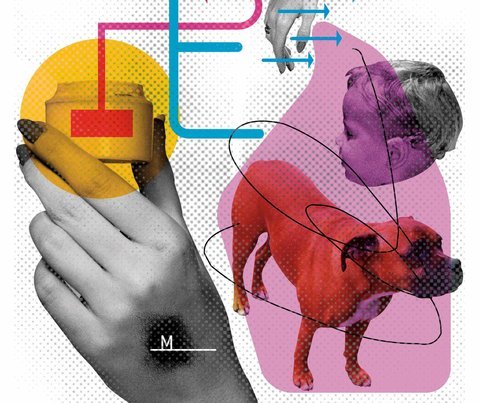When Hormone Creams Expose Pets to Risks

Veterinarians around the country are reporting a strange phenomenon: spayed dogs and cats, even some puppies and kittens, are suddenly becoming hormonal.
In female pets, the symptoms resemble heat: swollen genitals, bloody discharge and behavioral problems. Male animals are showing up with swollen breast tissue and hair loss. Standard treatments and even repeated operations have had no effect.
Now vets have identified the culprit. The pets were all owned by women who used hormone creams on their hands, arms and legs to counter symptoms of menopause. Animals who licked or cuddled their owners, or rubbed up against their legs, were being inadvertently exposed to doses of hormone drugs.
These anecdotal reports, about 20 of which were first collected by the Veterinary Information Network, a news service for veterinarians, suggest that many women are not taking proper precautions when using topical hormone products — putting not only pets but also family members at risk for hormone exposure.
“The dogs are licking and rubbing the treated area and absorbing the drug, which is putting them back into heat,” said Dr. Terry Clekis, a veterinarian in Bradenton, Fla. Dr. Clekis has seen about five cases of pet exposure to menopause creams, including a dog that appeared to go into heat about six months after being spayed.
Dr. Clekis feared he had left remnants of ovarian tissue behind after the spaying. So he repeated it, but found nothing. It was his wife, chatting with the pet owner, who discovered she was using a hormone cream. Once the owner took precautions against exposing her pet, the symptoms disappeared.
The Food and Drug Administration issued a warning in the summer after eight children exposed to the estrogen spray Evamist showed signs of premature puberty like nipple swelling and enlarged breasts. The agency also received two reports of dogs exposed to Evamist, and last year it issued another warning after eight children were exposed to topical testosterone.
Use of topical estrogen, in the form of creams, sprays and gels, has surged since a major government study linked oral menopause drugs with a higher risk of heart attacks and cancer.
Last year, doctors wrote 440,000 prescriptions for brand-name topical estrogen products alone, nearly triple the 2006 figure, according to IMS Health, a drug information service. And those numbers do not capture the estimated one million women using compounded hormone creams, which are custom-mixed by pharmacists and have been widely promoted as an alternative to commercial menopause drugs — even though the F.D.A. has said these so-called bio-identical hormones are no safer than hormones from drug companies. (The compounds’ popularity surged after the former sitcom star Suzanne Somers wrote two books claiming they delivered many health benefits.)
Dr. Cynthia A. Stuenkel, an endocrinologist at the University of California, San Diego, and a former president of the North American Menopause Society, said the society was surveying its members to collect case reports of inadvertent hormone exposure to pets or children. The problem, she added, is that the doctors who prescribe the drugs typically treat older women, but the doctors who see the problems are pediatricians and veterinarians.
“We need to connect the dots between these groups so pediatricians and vets think of it early before subjecting these children and animals to extensive testing,” she said. But some vets say women aren’t forthcoming about the use of hormone drugs because it simply doesn’t occur to them that it might be related to a pet’s problem.
Dr. Walter R. Threlfall, a veterinarian who specializes in reproductive health, had a case involving a small lap dog that was experiencing a regular bloody discharge. During three different visits he asked the owner if the dog could have been exposed to an estrogen product, and she answered no each time before finally acknowledging she had been using an estrogen cream on her arm.
“The dog licks it off every night,” she told Dr. Threlfall, who said in an interview, “She spent lots of money on that dog, and I could have solved it the first time by telling her to get the dog off the estrogen cream.”
Dr. Richard Fried, owner of the Lincoln Square Veterinary Hospital in Manhattan, said he recently saw two cats that seemed to go back into heat after spaying by a different vet. Tests in one cat showed high blood levels of estrogen, but before he could spay it again, the cats’ breeder suggested that the culprit might be the owner’s hormone treatment.
“We are always warning pet owners to be careful about their medications,” Dr. Fried said. “But this is a much more insidious kind of problem that most people don’t think about.”
Dr. Stuenkel says women should be counseled about safe use of the drugs.
After using a topical hormone cream, they should thoroughly wash their hands before handling food, children or pets. Products should dry completely before the user comes into contact with people or animals, and women may want to consider changing the area where they apply the cream or covering it with long sleeves or slacks.
“We’ve learned a lot from these puppy stories,” Dr. Stuenkel said. “People are letting dogs lick their hands after using the cream or holding them when the cream is fresh on them. We need to teach women to be sensible about how they use these products.”
From NYTimes.com. A version of this article also appeared in print on Oct. 26, 2010, on page D5 of the New York edition of The Times.
- Behavior (15)
- Caring for your pet (292)
- cat (16)
- Community Events (20)
- dog (17)
- From Our Clients (15)
- Happy Tails (12)
- News (454)
- Press (53)
- Products (2)
- Questions (4)
- Recalls (1)
- Special Offers (6)
- Tips & Advice (231)
- Uncategorized (21)
- Veterinary Services (49)
